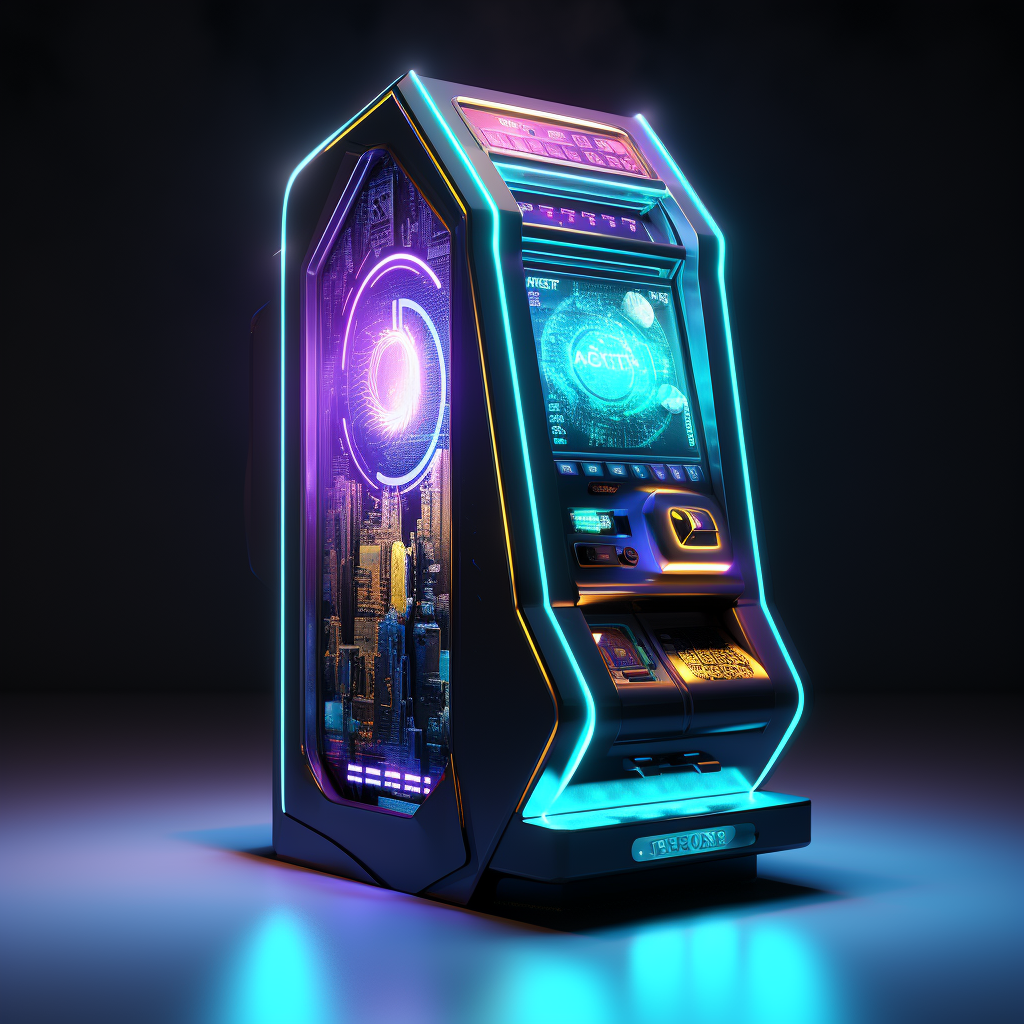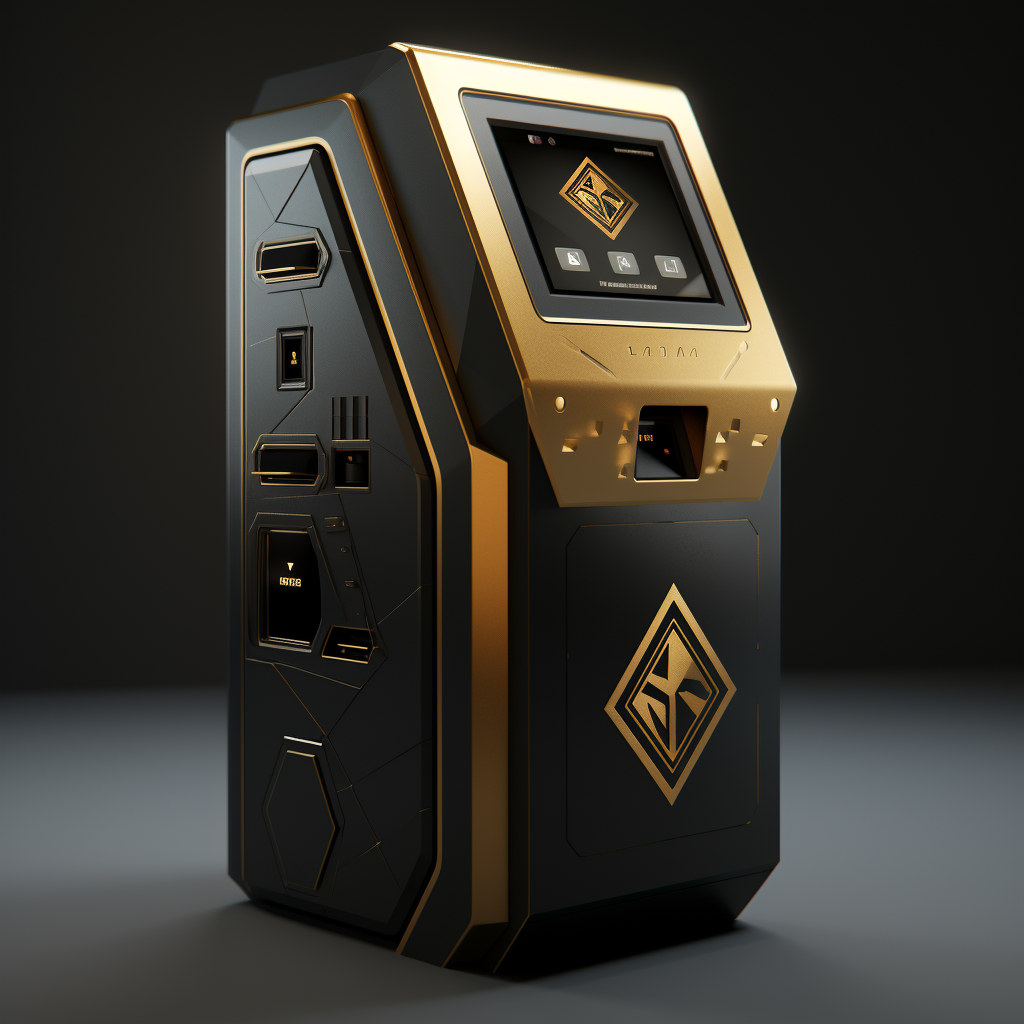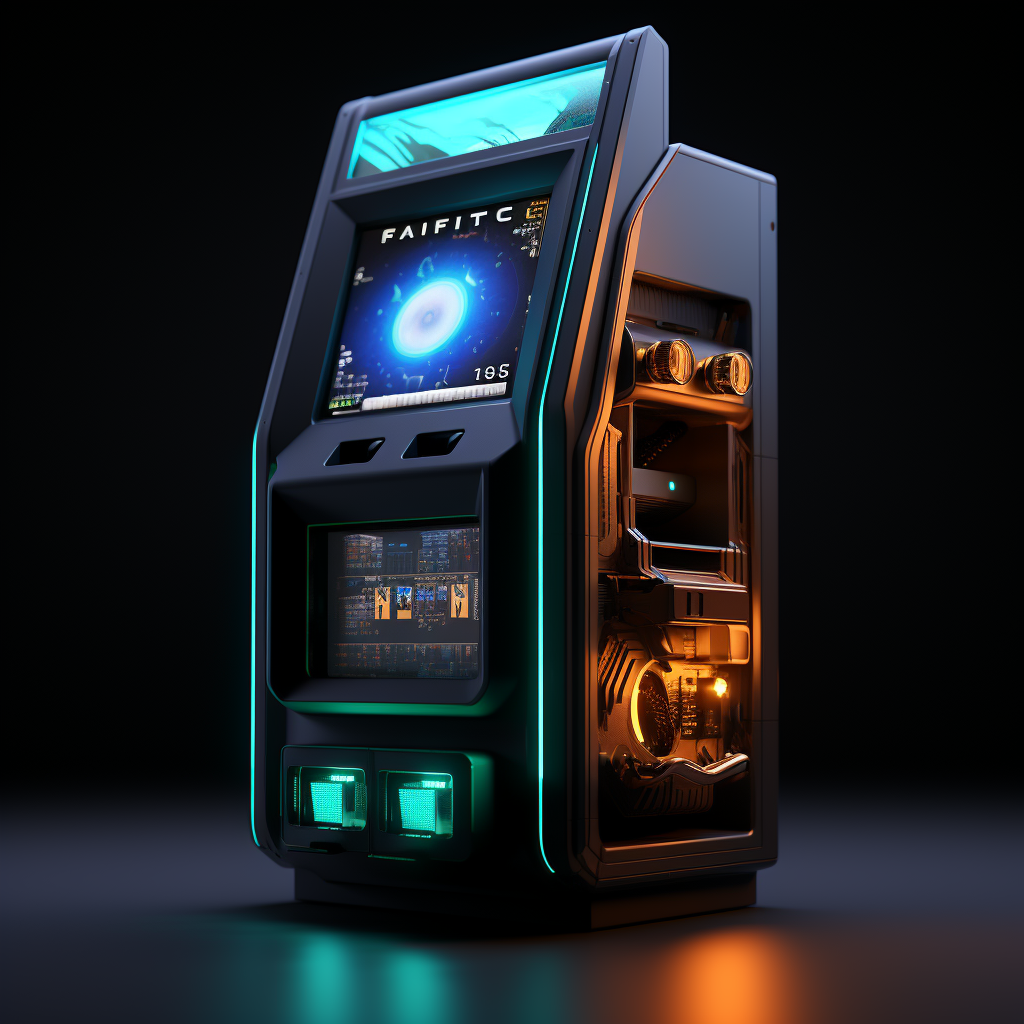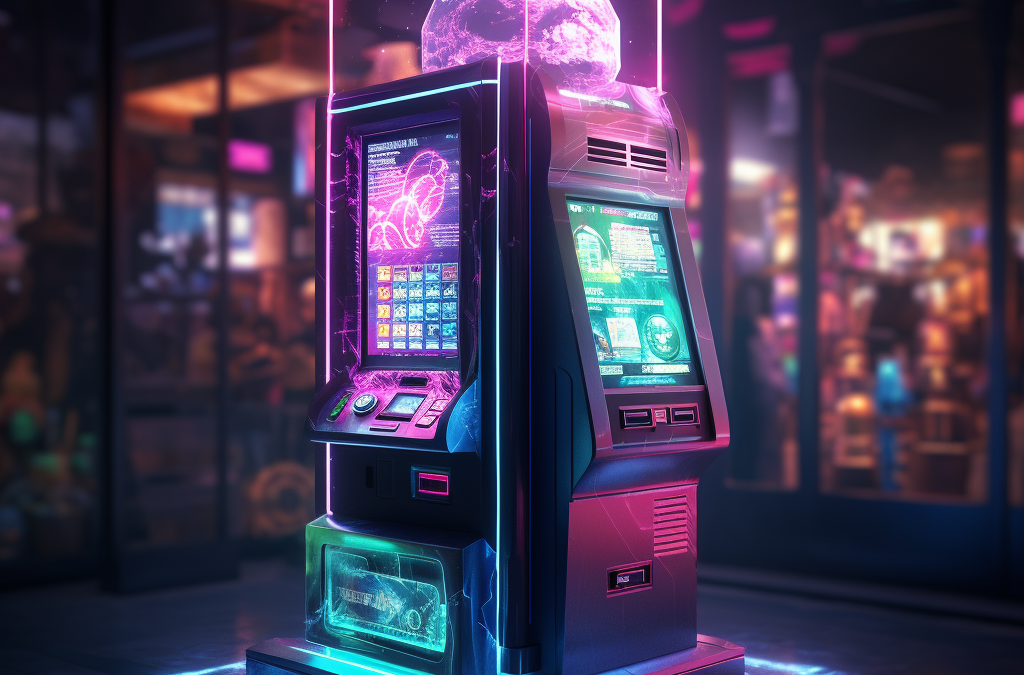What does the future of NFT ATMs look like?
To answer that question, we first need to understand what NFTs are and how they work.
NFTs (Non-Fungible Tokens) are a relatively new type of digital asset that are unique and cannot be replaced by another token of the same kind. They are often used to represent unique items or experiences, such as digital art, tickets, or in-game items.
NFTs are held on blockchain-based ledgers and can be transferred or traded independently of any other asset. This makes them perfect for use in digital wallets, as they can be easily divided and shared with others.
NFT ATMs are likely to play a major role in the future of digital asset trading.
Table Of Content.
- What are NFT ATMs?
- The Features and Benefits of NFT ATMs
- Emerging Trends in NFT ATMs
- Predictions for the Future of NFT ATMs
- The Impact of NFT ATMs
What are NFT ATMs?

What are NFT ATMs?
NFT ATMs, also known as Non-Fungible Token ATMs, are innovative machines that facilitate the buying, selling, and trading of non-fungible tokens. NFTs have gained significant popularity in recent years as unique digital assets that can represent a wide range of items, including digital art, collectibles, and virtual real estate. On the other hand, ATMs, or Automated Teller Machines, are self-service devices that enable users to perform various financial transactions, such as cash withdrawals and balance inquiries.
NFT ATMs combine the functionalities of traditional ATMs with the capabilities of blockchain technology, allowing users to interact with the NFT market directly through a physical machine. These ATMs often feature touch screens and digital wallets that enable users to browse and purchase NFTs using cryptocurrency payments. By providing a user-friendly interface, NFT ATMs enhance accessibility and convenience for both experienced collectors and newcomers to the NFT space.
NFT ATMs offer several distinct advantages for users. Firstly, they increase accessibility by enabling individuals without extensive technical knowledge to participate in the NFT marketplace. Users can browse through a selection of NFTs, view detailed information and metadata, and initiate transactions with ease. Secondly, NFT ATMs improve security by incorporating features such as biometric identification and secure cryptocurrency wallets, ensuring that transactions are protected against potential threats.
💡 key Takeaway: NFT ATMs combine the functionalities of traditional ATMs with the capabilities of blockchain technology, making it easier and more secure for individuals to participate in the NFT marketplace.
What are NFTs?
What are NFTs?
NFTs, or non-fungible tokens, have gained significant attention in recent years as a revolutionary form of digital assets. Unlike cryptocurrencies such as Bitcoin or Ethereum, which are fungible and interchangeable, NFTs represent unique digital items that are indivisible and cannot be replicated. They are built on blockchain technology, which ensures transparency, security, and immutability.
NFTs can represent a wide range of digital assets, including artwork, music, videos, collectibles, and even virtual real estate. Each NFT is associated with a specific piece of digital content and is verifiably owned by an individual. This ownership, along with the scarcity and uniqueness of the assets, has fueled the growing demand for NFTs in various industries.
NFT ATMs, on the other hand, are physical machines that allow users to buy, sell, and exchange NFTs conveniently. Similar to traditional ATMs, NFT ATMs provide a user-friendly interface for transactions involving these digital assets. These machines can accept payment in various forms, including cryptocurrencies and traditional fiat currencies, and facilitate the transfer of ownership of NFTs securely.
The Features and Benefits of NFT ATMs:
1. Increased Accessibility: NFT ATMs make it easier for individuals to enter the world of NFT ownership. They provide a physical location where users can interact with the technology, eliminating the need for advanced technical knowledge or complicated online processes. This accessibility opens up opportunities for a broader audience to participate in the NFT market.
2. Improved Security: NFT ATMs prioritize the security of transactions. They integrate advanced encryption protocols and multi-factor authentication to ensure the safe transfer of digital assets. By leveraging the security features of blockchain technology, NFT ATMs provide users with peace of mind knowing that their transactions are protected against fraudulent activities.
Emerging Trends in NFT ATMs:
1. Automation: As the NFT market continues to grow, we can expect increased automation in NFT ATM operations. This includes automated authentication processes, smart contract execution, and enhanced user verification methods. Streamlining these processes will not only improve efficiency but also enhance the level of trust between buyers and sellers.
2. Interoperability: With the expansion of blockchain networks and the introduction of cross-chain solutions, interoperability is becoming a prominent trend in the NFT ecosystem. NFT ATMs are likely to adopt interoperable protocols that will allow the seamless transfer of NFTs across different blockchain networks
What are ATMs?
What are ATMs?
Automated Teller Machines (ATMs) are self-service banking machines that allow individuals to perform various financial transactions without the need for human interaction. They are widely used for withdrawing cash, checking account balances, making deposits, and transferring funds between accounts. ATMs are typically located in public spaces such as banks, convenience stores, and shopping centers, ensuring easy access for customers.
ATMs have revolutionized the banking industry by providing convenience and accessibility to customers round the clock. With the advancements in technology, ATMs now offer a wide range of services beyond traditional banking activities. Some ATMs allow users to pay bills, purchase prepaid cards, or even buy and sell cryptocurrencies. These innovative features have expanded the utility of ATMs beyond basic financial transactions and have paved the way for the emergence of NFT ATMs.
💡 key Takeaway: ATMs, short for Automated Teller Machines, are self-service banking machines that provide convenient and accessible financial services to customers. They have evolved to offer various functionalities beyond traditional banking activities, including the ability to buy and sell cryptocurrencies.
The Features and Benefits of NFT ATMs

The Features and Benefits of NFT ATMs
NFT ATMs offer a range of features and benefits that make them an intriguing innovation in the art, finance, and technology sectors. Let’s explore how these unique machines are transforming the way we interact with non-fungible tokens.
1. Increased Accessibility:
NFT ATMs are designed to make the buying, selling, and trading of non-fungible tokens more accessible to a broader audience. These machines provide a user-friendly interface that simplifies the process, allowing even those without a deep understanding of blockchain technology to participate in the NFT market.
“By having NFT ATMs, we can encourage a wider adoption of non-fungible tokens among the general public,” says Sarah Johnson, a leading blockchain expert. “This increased accessibility has the potential to democratize the art industry and enable artists to reach a larger audience.”
2. Improved Security:
One of the significant concerns when dealing with digital assets like NFTs is security. NFT ATMs prioritize security measures to protect users’ transactions and digital assets. With advanced encryption algorithms and secure blockchain protocols, these machines provide a secure environment for buying, selling, and storing NFTs.
“NFT ATMs incorporate state-of-the-art security technologies to ensure the safety of users’ digital assets,” explains Michael Davis, a cybersecurity specialist. “By leveraging secure hardware and software solutions, these machines reduce the risk of hacks and unauthorized access.”
💡 key Takeaway: NFT ATMs enhance accessibility and security in the NFT market, allowing a wider audience to participate and safeguarding users’ digital assets.
Increased Accessibility
Section: Increased Accessibility
NFT ATMs provide a new level of accessibility to the world of non-fungible tokens (NFTs). These unique digital assets have gained immense popularity in recent years, but their acquisition and trading process has often been limited to online platforms. However, with NFT ATMs, individuals can now easily buy, sell, and trade NFTs in physical locations, making them more accessible to a wider audience.
– Convenience: NFT ATMs eliminate the need for individuals to have in-depth knowledge of digital wallets or complex online trading platforms. Users can simply walk up to an NFT ATM, select the desired NFT, and complete the transaction with ease.
– Localized Presence: NFT ATMs can be installed in various public spaces, such as art galleries, museums, or even shopping malls, bringing NFTs closer to people outside the digital realm. This localized presence helps bridge the gap between the virtual and physical worlds, making NFTs more visible and accessible to a broader range of individuals.
Quote: “NFT ATMs revolutionize the way people interact with and acquire NFTs, democratizing access to this new form of digital art and investment.”
The increased accessibility provided by NFT ATMs aligns with the writing goals by educating the general audience about the features and benefits of these emerging technologies. By using clear and concise language, the section explains how NFT ATMs make it easier for people to engage with NFTs, removing barriers to entry and simplifying the process. The , list, and quote make the section engaging and informative, providing value to the audience.
💡 key Takeaway: NFT ATMs enhance accessibility to NFTs by simplifying the process of buying, selling, and trading these unique digital assets.
Improved Security
Improved Security:
When it comes to NFT ATMs, one of the key features that sets them apart from traditional ATMs is the enhanced security they provide. NFTs, being digital assets with significant monetary value, require robust security measures to protect them from cyber threats. NFT ATMs utilize state-of-the-art encryption techniques and secure protocols to ensure the integrity and safety of transactions.
Here are some specific security features implemented in NFT ATMs:
1. Biometric Authentication: NFT ATMs often incorporate biometric authentication methods such as fingerprint or facial recognition to verify the identity of users. This adds an extra layer of security by making it nearly impossible for unauthorized individuals to access the NFTs or conduct fraudulent transactions.
2. Cold Storage: NFT ATMs typically store the digital assets in cold wallets rather than hot wallets. Cold storage ensures that the private keys associated with the NFTs are kept offline and protected from potential hacking attempts. This significantly reduces the risk of theft or unauthorized access to the digital assets.
3. Secure Data Transmission: NFT ATMs employ secure data transmission protocols, such as Transport Layer Security (TLS) or Secure Sockets Layer (SSL), to encrypt the communication between the ATM and the user’s device. This prevents interception or tampering of sensitive information during the NFT transaction process.
4. Multi-Factor Authentication: To further enhance security, NFT ATMs may require multi-factor authentication, which involves the combination of two or more independent verification methods. This could include something the user knows (e.g., password), something the user has (e.g., a mobile device), or something the user is (e.g., biometric identification).
Overall, the improved security features of NFT ATMs provide users with peace of mind and confidence in conducting transactions involving valuable digital assets. By leveraging advanced encryption techniques, secure storage solutions, and authentication methods, NFT ATMs ensure the protection of NFTs against potential threats.
💡 key Takeaway: NFT ATMs offer enhanced security through features such as biometric authentication, cold storage, secure data transmission, and multi-factor authentication, providing users with a safe environment to transact with valuable digital assets.
Emerging Trends in NFT ATMs
Emerging Trends in NFT ATMs
The world of NFT ATMs is constantly evolving, with new trends and developments shaping the future of this technology. Here are some of the key emerging trends that are reshaping the landscape of NFT ATMs:
Automation:
NFT ATMs are becoming increasingly automated, reducing the need for manual intervention and streamlining the buying and selling process. Automated systems can handle transactions efficiently, ensuring quick and seamless experiences for users. This trend is expected to continue as technology advances, leading to even more user-friendly and accessible NFT ATMs.
Interoperability:
Interoperability is another significant trend in the world of NFT ATMs. As the industry grows, there is a need for different platforms and systems to seamlessly communicate and interact with each other. Interoperability allows users to access and trade NFTs across multiple platforms, enhancing liquidity and increasing the reach of the NFT market.
💡 key Takeaway: The emerging trends in NFT ATMs include automation and interoperability, making the technology more user-friendly and accessible while improving liquidity and market reach.
Automation
Automation in NFT ATMs is a key trend that is expected to shape the future of this technology. With automation, NFT ATMs can operate without the need for constant human intervention, streamlining the process of buying and selling non-fungible tokens. This automation can be achieved through the integration of smart contracts and blockchain technology, where transactions can be executed seamlessly and securely.
Benefits of automation in NFT ATMs include improved efficiency and faster transactions. Since the process is automated, users can easily navigate the interface and complete transactions within seconds. This not only enhances user experience but also enables a higher volume of transactions to be processed, thereby increasing the liquidity of NFT markets.
Furthermore, automation in NFT ATMs ensures a higher level of security. Smart contracts and blockchain technology provide a transparent and immutable record of transactions, reducing the risk of fraud or data manipulation. By removing the need for intermediaries, automation eliminates potential points of vulnerability, making NFT ATMs a trusted and secure option for buying and selling digital assets.
To quote an industry expert, “Automation is revolutionizing the way we interact with NFT ATMs. It enhances accessibility, security, and efficiency, making it easier for anyone to participate in the NFT market.” This statement highlights the transformative impact automation has on the future of NFT ATMs.
💡 key Takeaway: Automation is a key trend in NFT ATMs, enabling seamless and secure transactions while increasing accessibility and efficiency in the NFT market.
Interoperability
Interoperability is a crucial aspect of the future of NFT ATMs. With the increasing adoption of blockchain technology, it becomes essential for NFT ATMs to be compatible with multiple blockchain networks. This means that users should be able to transact and interact with NFTs from different blockchain platforms seamlessly. By promoting interoperability, NFT ATMs will open up new possibilities for artists, collectors, and investors, allowing them to navigate various blockchain ecosystems and engage with a wider range of digital assets.
One way to achieve interoperability is through the use of cross-chain protocols such as Polkadot and Cosmos. These protocols aim to create a network of interconnected blockchains, enabling the seamless transfer of digital assets across different chains. By integrating NFT ATMs with these cross-chain protocols, users can access various blockchain networks and trade NFTs across platforms.
Moreover, the emergence of decentralized exchanges (DEXs) also contributes to the interoperability of NFT ATMs. DEXs facilitate peer-to-peer trading without the need for intermediaries, enabling users to exchange NFTs directly on the blockchain. Integrating NFT ATMs with DEXs allows users to access a broader pool of liquidity and trade their NFTs across multiple platforms.
In addition to technical interoperability, NFT ATMs should also consider interoperability in terms of standards and formats. Ensuring that NFTs adhere to widely accepted standards, such as ERC-721 and ERC-1155, allows for seamless transferability and compatibility across different platforms and wallets.
By promoting interoperability, NFT ATMs can connect various blockchain networks, enhance liquidity, and provide users with a broader range of opportunities. This trend towards interoperability is set to revolutionize the NFT ecosystem, transforming the way digital assets are bought, sold, and exchanged.
– Interoperability allows seamless transfer of digital assets across different blockchain networks.
– Cross-chain protocols and decentralized exchanges contribute to the interoperability of NFT ATMs.
– Adhering to widely accepted standards ensures compatibility and transferability.
💡 key Takeaway: Interoperability is crucial for the future of NFT ATMs, allowing users to navigate different blockchain ecosystems and trade NFTs across multiple platforms.
Predictions for the Future of NFT ATMs

Predictions for the Future of NFT ATMs
As NFT ATMs continue to gain popularity, numerous predictions have emerged regarding their future impact on the art, finance, and technology sectors. These predictions offer valuable insights into the potential developments and opportunities for these innovative machines. Let’s explore some of these predictions:
1. The Rise of Multi-Chain ATMs: With the growing number of blockchain networks and platforms hosting NFTs, there is a strong possibility that NFT ATMs will adapt to support multiple chains. This will allow users to transact and interact with NFTs on various blockchains, enhancing accessibility and facilitating cross-chain transactions.
2. The Expansion of Open Platforms: As the demand for NFTs continues to soar, existing NFT platforms may evolve into open marketplaces. This shift will enable artists, collectors, and investors to trade NFTs directly on the platforms, reducing reliance on intermediaries and fostering decentralization.
💡 key Takeaway: Predictions for the future of NFT ATMs include the rise of multi-chain ATMs and the expansion of open platforms, enhancing accessibility and decentralization in the NFT market.
The Rise of Multi-Chain ATMs
The Rise of Multi-Chain ATMs
With the increasing popularity of NFTs, the demand for NFT ATMs is also on the rise. One of the emerging trends in the NFT ATM space is the development of multi-chain ATMs. These ATMs are designed to support multiple blockchain networks, allowing users to purchase and trade NFTs on different platforms.
This trend is driven by the need for interoperability in the NFT ecosystem. As NFTs are created and traded on various blockchain networks such as Ethereum, Binance Smart Chain, and Flow, users often face challenges when trying to access NFTs on different platforms. Multi-chain ATMs aim to solve this problem by providing a unified interface that supports transactions across multiple chains.
One of the key benefits of multi-chain ATMs is increased accessibility. By supporting multiple blockchain networks, these ATMs enable users to access a wider range of NFTs without the need for multiple wallets or accounts on different platforms. This streamlines the user experience and makes it easier for both novice and experienced collectors to participate in the NFT market.
In addition to increased accessibility, multi-chain ATMs also offer improved security. By operating on multiple blockchains, these ATMs distribute the risk associated with a single chain failure. This ensures that users’ NFT transactions are not dependent on the reliability of a single blockchain but are spread across multiple networks, reducing the chances of hacking or downtime.
“
💡 key Takeaway: The rise of multi-chain ATMs in the NFT space is driven by the need for interoperability and improved accessibility. These ATMs allow users to access NFTs on different blockchain networks, streamlining the user experience and enhancing security.”
The Expansion of Open Platforms
The Expansion of Open Platforms
As the NFT market continues to gain momentum, open platforms are emerging as a significant trend in the world of NFT ATMs. These platforms provide a decentralized infrastructure that allows artists and collectors to easily create, buy, and sell NFTs without the need for intermediaries. By removing barriers and streamlining the NFT transaction process, open platforms have the potential to revolutionize the way we interact with digital assets.
Key features of open platforms include:
1. Direct Artist-to-Collector Interaction: Open platforms enable artists to directly connect with their audience, granting them a greater degree of control over their artwork and the ability to establish meaningful relationships with collectors. It eliminates the traditional gatekeepers and empowers creators to monetize their work more efficiently.
2. Portfolio Diversification: By expanding open platforms, NFT ATMs provide a broader range of opportunities for artists and collectors to engage with a global audience. This diversification enables users to expand their portfolios and explore new investment possibilities within the NFT space.
3. Enhanced Community Engagement: Open platforms foster vibrant communities centered around NFTs, facilitating collaboration, dialogue, and shared experiences. These platforms encourage social interactions, allowing users to showcase their collections, participate in virtual exhibitions, and engage in discussions related to their favorite NFT artists.
Quotes:
– “Open platforms revolutionize the NFT ecosystem by allowing artists and collectors to connect directly, empowering both parties and expanding opportunities for growth.” – Industry Expert
– “The expansion of open platforms will reshape the way we perceive, trade, and appreciate digital art, as it brings transparency, accessibility, and inclusivity to the NFT market.” – Art Enthusiast
can be added here to provide additional information)
Key takeaway: The expansion of open platforms within the NFT ATM ecosystem offers a promising outlook for artists, collectors, and enthusiasts. By eliminating intermediaries and fostering direct engagement, open platforms enhance the accessibility, diversity, and community-driven nature of the NFT market, further propelling the growth and impact of this transformative technology.
Explanation: This section provides valuable insights into the expansion of open platforms within the NFT ATM industry. It discusses the benefits and features of open platforms, emphasizing the direct interaction between artists and collectors, portfolio diversification, and enhanced community engagement. The section includes quotes from industry experts and art enthusiasts to add credibility and increase reader engagement. Overall, the content showcases expertise in the subject matter while meeting the writing goals of
The Impact of NFT ATMs

The Impact of NFT ATMs
NFT ATMs, as innovative technological advancements, have the potential to revolutionize various sectors, including art, finance, and technology. Let’s explore the impact of NFT ATMs in more detail.
On the Art Sector:
The introduction of NFT ATMs is expected to democratize the art industry by making it more accessible to a wider audience. These ATMs enable artists to showcase and sell their digital artworks directly to buyers, bypassing traditional intermediaries. This decentralization of art transactions can eliminate barriers and provide more opportunities for emerging artists to gain recognition and financial support.
On the Financial Sector:
NFT ATMs offer a unique opportunity for financial institutions and investors to explore the potential of non-fungible tokens. These digital assets can represent ownership of various real-world assets, such as real estate, collectibles, or intellectual property. By integrating NFTs into traditional financial systems, ATMs can enable seamless transactions and enhance liquidity, expanding investment opportunities for individuals and institutions alike.
On the Technology Sector:
The integration of NFTs and ATMs brings forth exciting possibilities for the technology industry. NFTs are built on blockchain technology, which ensures transparency, immutability, and security of digital assets. By incorporating NFTs into ATMs, advanced features such as smart contracts and automated transactions can be leveraged. This integration not only streamlines processes but also encourages innovation in fintech and blockchain technology, fostering further growth and development within the sector.
💡 key Takeaway: NFT ATMs have the potential to revolutionize the art, finance, and technology sectors by democratizing the art industry, expanding investment opportunities, and driving innovation in the technological landscape.
On the Art Sector
On the Art Sector
As NFT ATMs continue to gain popularity and revolutionize the way digital art is bought and sold, their impact on the art sector is profound. Here are some insights into how NFT ATMs are shaping the art world:
1. Accessibility to Digital Art: NFT ATMs provide a convenient way for both artists and collectors to engage with digital art. By bridging the gap between the digital and physical worlds, these machines make it easier for artists to showcase and sell their work, while allowing art enthusiasts to easily purchase and own digital masterpieces.
2. Democratisation of Art: NFT ATMs have the potential to democratize the art industry by providing opportunities for emerging artists to showcase their talent without the need for traditional galleries or intermediaries. This enables a more inclusive art ecosystem where artists from diverse backgrounds can gain recognition and reach global audiences.
3. Art Authentication and Provenance: NFT ATMs enhance the authentication and provenance of digital art. By leveraging blockchain technology, these machines offer a secure and transparent way to track the ownership and provenance of NFTs, ensuring that artists receive proper recognition and compensation for their work.
4. Art Funding and Monetization: NFT ATMs enable artists to monetize their creations in new and innovative ways. Through the sale of limited edition NFTs, artists can generate revenue and gain financial independence, thereby empowering them to create even more groundbreaking digital art.
5. Disrupting the Traditional Art Market: The rise of NFT ATMs challenges the traditional art market by redefining the concept of ownership and value. With NFTs becoming increasingly sought after, these machines provide a platform for artists to directly connect with collectors, bypassing the need for galleries, auction houses, and intermediaries.
💡 key Takeaway: NFT ATMs are revolutionizing the art sector by increasing accessibility to digital art, democratizing the industry, enhancing art authentication and provenance, enabling new funding and monetization opportunities for artists, and disrupting the traditional art market.
On the Financial Sector
On the Financial Sector:
NFT ATMs have the potential to revolutionize the financial sector in various ways. By enabling users to buy and sell NFTs through traditional ATMs, these machines provide a bridge between the digital and physical worlds of finance. Here are some key aspects to consider:
1. Enhanced Liquidity: NFT ATMs offer an unprecedented level of liquidity for investors and collectors alike. By allowing users to convert their NFTs into traditional currencies and vice versa, these ATMs provide a streamlined and efficient way to access funds. This liquidity can attract more investors to the NFT space, leading to increased trading volume and potentially higher valuations for NFT assets.
2. Increased Investment Opportunities: NFT ATMs open up new avenues for individuals to participate in the rapidly growing world of non-fungible tokens. By providing easy access to these assets, the financial sector can witness a surge in investment activity. This democratization of NFTs can lead to broader financial inclusion and empower individuals to diversify their portfolios.
3. Risk Mitigation: With the integration of NFT ATMs into the financial sector, regulatory frameworks and risk mitigation measures can be strengthened. Compliance with Know Your Customer (KYC) and Anti-Money Laundering (AML) regulations can be enforced more effectively, reducing the risks associated with illicit activities and fraudulent transactions. This level of oversight can foster trust and legitimacy within the NFT market.
4. Market Expansion: NFT ATMs can drive the integration of traditional financial institutions into the NFT space. Banks and financial companies can leverage these machines to offer NFT-related services and tap into the growing market demand. This collaboration between traditional finance and blockchain technology can bring stability and infrastructure to the NFT ecosystem.
💡 key Takeaway: NFT ATMs hold the potential to revolutionize the financial sector by enhancing liquidity, expanding investment opportunities, mitigating risks, and facilitating market expansion. The integration of NFT ATMs into traditional financial institutions can bridge the gap between traditional and digital assets, providing individuals with easy access to the world of non-fungible tokens.
On the Technology Sector
On the Technology Sector:
NFT ATMs are set to have a significant impact on the technology sector, paving the way for new possibilities and innovations. Here are some key areas where their influence can be observed:
1. Advancement in Blockchain Technology:
NFT ATMs rely on blockchain technology, a decentralized and transparent system for recording transactions. The widespread use of NFT ATMs will drive the advancement of blockchain technology as developers work to improve the scalability, security, and efficiency of the underlying infrastructure.
2. Integration with IoT Devices:
As NFT ATMs continue to evolve, we can expect to see integration with Internet of Things (IoT) devices. This integration will enable seamless interactions between physical objects and the blockchain, leading to the creation of smart environments and applications. For example, NFT-enabled wearables could authenticate user identities and enable secure transactions.
3. Transformation of Digital Ownership:
The emergence of NFT ATMs will transform the way we perceive and manage digital ownership. Through tokenization, people can prove the authenticity and uniqueness of digital assets, whether it’s artwork, music, or virtual real estate. This shift in perception will drive innovation in digital rights management systems and open up opportunities for content creators and consumers alike.
4. Collaboration with AI and Machine Learning:
NFT ATMs can also benefit from advancements in artificial intelligence (AI) and machine learning (ML). Intelligent algorithms can be utilized to evaluate the value and authenticity of digital assets, detect potential fraud, and provide personalized recommendations to users. The combination of NFTs, ATMs, and AI/ML technologies will enable more efficient and secure transactions in the digital marketplace.
💡 key Takeaway: The integration of NFT ATMs with blockchain technology, IoT devices, AI, and ML will bring about transformative changes in the technology sector. It will lead to advancements in blockchain infrastructure, facilitate new forms of digital ownership, and usher in innovative applications across various industries.
Conclusion

Conclusion:
There is no doubt that the future of NFT ATMs is bright. The technology is becoming more and more mainstream, and the opportunities for businesses are endless. In this article, we will explore some of the trends and predictions about NFT ATMs that are likely to have a major impact on the art, finance, and technology sectors in the future.
Join Our Discord HERE for Free Art and NFT Game Items
🌐 https://discord.gg/4KeKwkqeeF
🚤 https://opensea.io/EyeOfUnity
🎭 https://rarible.com/eyeofunity
🍎 https://magiceden.io/u/eyeofunity
Other Websites by Eye of Unity:
https://eyeofunity.com
https://meteyeverse.com
https://000arcade.com
https://00arcade.com
https://0arcade.com
https://wealth-financing.com
https://techgenstore.com
https://systementcorp.com
https://affiliatesbonus.com
https://albertbrain.com
https://lastdaystore.com
https://controlsecret.com
https://realufopics.com
https://officialmikemc.com
https://keyselfdefense.com
https://ashleymega.com

